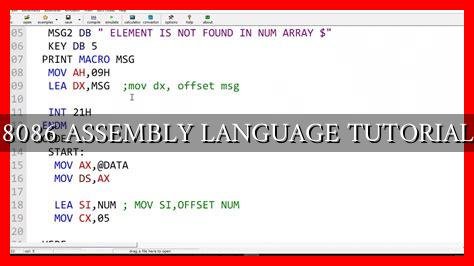-
Table of Contents
Understanding 8086 Assembly Language: A Comprehensive Tutorial
Assembly language programming is a low-level programming language that is specific to a particular computer architecture. In this tutorial, we will delve into the intricacies of 8086 assembly language, which is commonly used for programming Intel 8086 microprocessors. By the end of this article, you will have a solid understanding of 8086 assembly language and be able to write basic programs using this language.
Introduction to 8086 Assembly Language
The Intel 8086 microprocessor was introduced in 1978 and is considered one of the first 16-bit microprocessors. Assembly language programming for the 8086 involves writing instructions that directly correspond to the machine language instructions executed by the processor. This allows for precise control over the hardware and efficient utilization of system resources.
Basic Concepts of 8086 Assembly Language
Registers
Registers are small storage locations within the processor that hold data temporarily.
. The 8086 microprocessor has several general-purpose registers, such as AX, BX, CX, DX, SI, DI, BP, and SP. These registers can be used to store data, perform arithmetic operations, and manipulate memory addresses.
Instructions
8086 assembly language instructions are mnemonic representations of machine language instructions. These instructions perform operations such as data movement, arithmetic calculations, logical operations, and control flow. Examples of instructions include MOV (move data), ADD (addition), SUB (subtraction), JMP (jump), and CMP (compare).
Writing Your First 8086 Assembly Language Program
Let’s write a simple program in 8086 assembly language that adds two numbers and displays the result:
“`assembly
; Program to add two numbers in 8086 assembly language
.model small
.stack 100h
.data
num1 dw 5
num2 dw 10
result dw ?
.code
main proc
mov ax, @data
mov ds, ax
mov ax, num1
add ax, num2
mov result, ax
mov ah, 09h
mov dx, offset result
int 21h
mov ah, 4ch
int 21h
main endp
end main
“`
In this program, we define two numbers (num1 and num2) in the .data section, add them together using the ADD instruction, and store the result in the variable result. We then use the INT 21h interrupt to display the result on the screen.
Resources for Learning 8086 Assembly Language
If you’re interested in delving deeper into 8086 assembly language programming, there are several resources available online that can help you enhance your skills:
- Tutorialspoint – Assembly Programming
- GeeksforGeeks – Assembly Language
- YouTube – Assembly Language Tutorials
Conclusion
8086 assembly language programming is a powerful tool for low-level system programming and optimization. By mastering the concepts and syntax of 8086 assembly language, you can gain a deeper understanding of computer architecture and develop efficient programs that leverage the capabilities of the Intel 8086 microprocessor. With practice and dedication, you can become proficient in writing complex programs in 8086 assembly language and unlock new possibilities in the world of computer programming.





